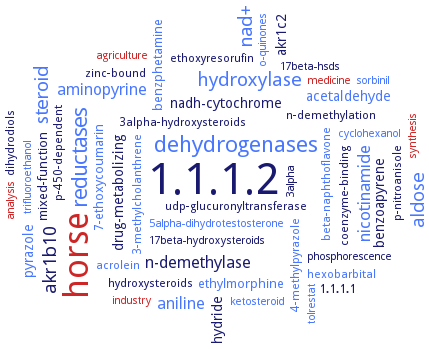1.1.1.2: alcohol dehydrogenase (NADP+)
This is an abbreviated version!
For detailed information about alcohol dehydrogenase (NADP+), go to the full flat file.

Word Map on EC 1.1.1.2 
-
1.1.1.2
-
horse
-
dehydrogenases
-
reductases
-
hydroxylase
-
steroid
-
nad+
-
aldose
-
akr1b10
-
nicotinamide
-
aniline
-
aminopyrine
-
n-demethylase
-
akr1c2
-
acetaldehyde
-
pyrazole
-
nadh-cytochrome
-
drug-metabolizing
-
benzoapyrene
-
hydride
-
benzphetamine
-
ethylmorphine
-
mixed-function
-
1.1.1.1
-
7-ethoxycoumarin
-
beta-naphthoflavone
-
udp-glucuronyltransferase
-
p-nitroanisole
-
4-methylpyrazole
-
3alpha-hydroxysteroids
-
coenzyme-binding
-
dihydrodiols
-
3-methylcholanthrene
-
n-demethylation
-
ethoxyresorufin
-
hydroxysteroids
-
acrolein
-
hexobarbital
-
p-450-dependent
-
zinc-bound
-
17beta-hsds
-
analysis
-
sorbinil
-
cyclohexanol
-
medicine
-
agriculture
-
trifluoroethanol
-
5alpha-dihydrotestosterone
-
ketosteroid
-
synthesis
-
17beta-hydroxysteroids
-
industry
-
o-quinones
-
tolrestat
-
3alpha
-
phosphorescence
- 1.1.1.2
- horse
- dehydrogenases
- reductases
- hydroxylase
- steroid
- nad+
- aldose
- akr1b10
- nicotinamide
- aniline
- aminopyrine
- n-demethylase
- akr1c2
- acetaldehyde
- pyrazole
-
nadh-cytochrome
-
drug-metabolizing
-
benzoapyrene
-
hydride
- benzphetamine
- ethylmorphine
-
mixed-function
-
1.1.1.1
- 7-ethoxycoumarin
- beta-naphthoflavone
-
udp-glucuronyltransferase
-
p-nitroanisole
- 4-methylpyrazole
-
3alpha-hydroxysteroids
-
coenzyme-binding
-
dihydrodiols
- 3-methylcholanthrene
-
n-demethylation
-
ethoxyresorufin
- hydroxysteroids
- acrolein
- hexobarbital
-
p-450-dependent
-
zinc-bound
- 17beta-hsds
- analysis
- sorbinil
- cyclohexanol
- medicine
- agriculture
- trifluoroethanol
- 5alpha-dihydrotestosterone
- ketosteroid
- synthesis
-
17beta-hydroxysteroids
- industry
- o-quinones
- tolrestat
-
3alpha
-
phosphorescence
Reaction
Synonyms
2� Adh, 3-DG-reducing enzyme, A3L14_07690, AAur_2040, ADH, ADH-1, ADH-2, ADH-I, ADH-II, ADH2, Adh319, ADH4, Adh6, AdhA, AdhB, AdhD, AKR1A1, AKR1A4, alcohol dehydrogenase C, alcohol dehydrogenase D, alcohol dehydrogenase [NADP(+)], Alcohol dehydrogenase [NADP+], aldehyde reductase, aldehyde reductase (NADPH2), aldehyde/ketone reductase, aldo-keto reductase, Aldo-keto reductase family 1 member A1, aldose reductase, ALDR, alipathic aldehyde reductase, ALR, ALR 1, ALR1, BdhA, bovine brain aldehyde reductase, CbADH, D-glucuronate reductase, daunorubicin reductase, DRD, EhADH1, FeADH, Gre2p, hexogenate dehydrogenase, high-Km aldehyde reductase, HvADH2, iron-containing alcohol dehydrogenase, KpADH, L-hexonate dehydrogenase, LB-RADH, LBADH, liver alcohol dehydrogenase, low-Km aldehyde reductase, mevaldate reductase, Mpd1, NADP(H)-dependent alcohol dehydrogenase, NADP+-dependent alcohol dehydrogenase, NADP-alcohol dehydrogenase, NADP-aldehyde reductase, NADP-dependent aldehyde reductase, NADP-linked aryl alcohol dehydrogenase, NADPH-aldehyde reductase, NADPH-cytochrome c reductase, NADPH-dependent ADH, NADPH-dependent aldehyde reductase, NADPH-dependent FALDR, NADPH-dependent fatty aldehyde reductase, NADPH-linked aldehyde reductase, nonspecific succinic semialdehyde reductase, Octopine dehydrogenase, putative iron alcohol dehydrogenase, PyAeADHII, rabbit kidney aldehyde-ketone reductase, RADH, ScADHVI, short-chain ADH, short-chain alcohol dehydrogenase, short-chain dehydrogenase/reductase, TBADH, TbADH1, Teth39_1597, Teth514_0564, TPN-L-hexonate dehydrogenase, TPNH-linked aldehyde reductase, TPNH-specific aldehyde reductase, triphosphopyridine nucleotide-linked aldehyde reductase, TsAdh319, Y63 protein, yeast alcohol dehydrogenase, YqhD


 results (
results ( results (
results ( top
top





